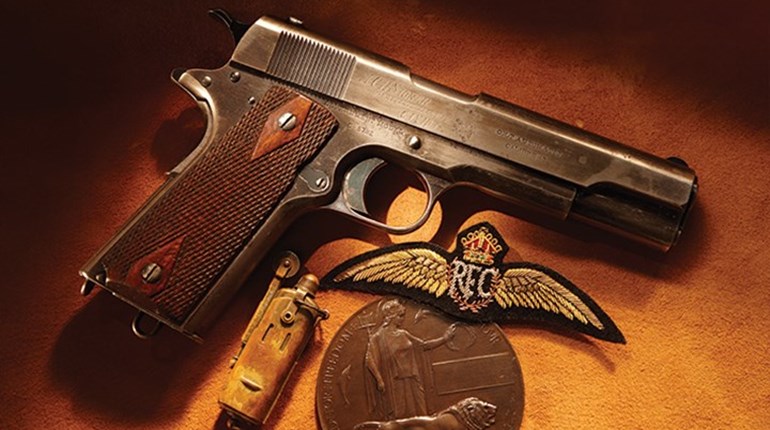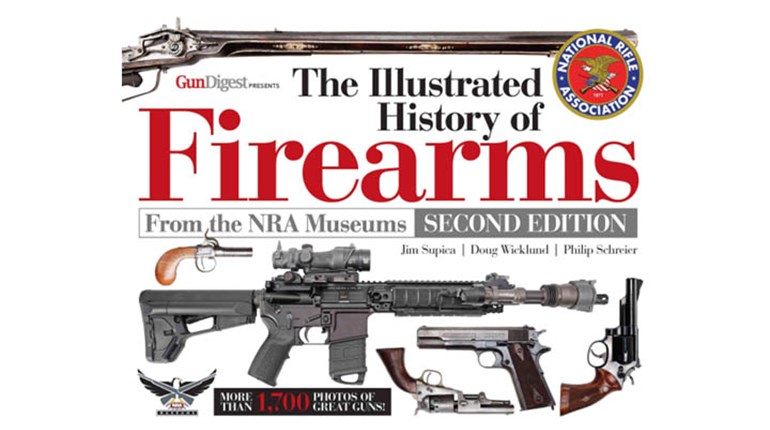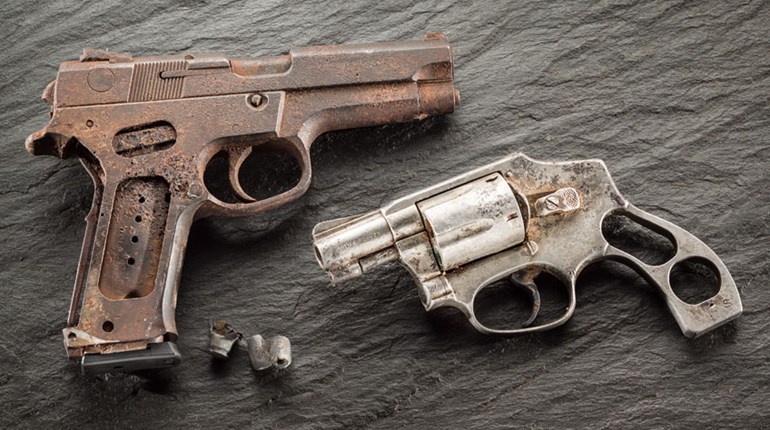
Pictured above: medieval hand cannon on display at the NRA National Firearms Museum.
The early firearms used in the Middle Ages were the simplest of firearms. Today’s modern semi-automatic handguns, shotguns and rifles all carry dozens more components than the tool that was the first gun of all: the hand cannon. But long ago, things were a lot simpler, before magazines, coil springs, gas-operated actions and “red-dot sights” came to be.
The hand cannon was really just a cannon on a stick—the crudest of iron tubes mounted on a wooden support post, capable of firing a blast of almost anything that could have been crammed into the bore. This early firearm served many armies across Europe in the 1300s and 1400s.
The portable hand cannon was hardly more than just a cast or forged iron or bronze barrel, pierced at one end to allow ignition. A blazing twig, a red hot nail, or a smoldering cord would have been used to ignite the powder charge (a crude mixture of sulfur, saltpeter and charcoal) inside the barrel. Portability was a relative term, as some hand cannons are known to have weighed in near 40 pounds. The crude iron tube was mounted to the carrying post with iron bands, cinched tightly to prevent the hand cannon from departing abruptly on its own trajectory during the firing process. There were no sights for the hand cannon and pointing the massive bore in the general direction of any close-by target probably sufficed.
During the medieval era, the smell of sulfur was considered to be linked with evil. Early gunpowder had sulfur as a major component, and the smell was pretty strong. Because of this, people that carried and employed the hand cannon in battle were also believed to need special dispensation and religious rites to counteract their close proximity to “devilish instruments.” Some surviving hand cannons are marked with crosses and other religious symbols to combat the evil-smelling blasts that were believed to turn period battlefields into the dominion of the devil.
The earliest firearm in the National Firearms Museum collection is a hand cannon that was found under a wall of a fortress near Salzburg, Austria, that was besieged in the 1350s. Once part of the Castle of Archduke Von Eugen of Salzburg Collection, it later came to the Art Institute of Chicago and was purchased by Dr. William Roberts to be part of his American Liberty Firearms Collection. The massive hook on the side of the barrel was not intended for any offensive purpose, but rather served as a retaining point that could be placed over the edge of a wall or tree branch during firing to mitigate recoil.
Despite the devastating blast that the hand cannon must have delivered, the time that it took to recharge the barrel safely with powder and projectiles limited its effectiveness. Multiple-barreled hand cannon are known with three or four “chambers” mounted together. These are the first examples of repeating firearms, but the extra capability came with a price: It added to the already considerable weight of the arm. Gunners carrying any type of hand cannon were well-versed in finding a secure location from which to fire—a location where the butt of the support post could be planted firmly against the ground, or where the landscape allowed the hand cannon to be discharged while supported by a wall or tree.
The early matchlocks were slightly improved. These were crude shoulder arms with a pivoting fuse that could be applied to the touch hole. While later matchlocks would have fitted pans holding priming powder next to the touch hole, the earliest examples were not much better than the hand cannon arms from which they were derived. Fired from a forked rest, these matchlock arms were generally slightly smaller in bore than hand cannons and were the ancestors of today’s shotguns. The matchlock’s smooth bore could fire a deadly pattern of large or small shot, as well as a single large projectile when necessary. For expeditions from the Old World to the New World, journals are filled with accounts of arquebuses and harquebuses being employed. The voyages of Columbus record that the three ships carried a variety of large and small cannon, including portable arms including arquebuses and crossbows.
With the end of the Middle Ages, new developments in arms were coming into play—more reliable wheel locks and later flintlocks that would, in time, change the battlefield almost as much as the first hand cannons did by their appearance.
A Brief History
Circa 850: Gunpowder first made in China
1004: First mention of gunpowder in Chinese literature
Circa 1250: Roger Bacon records formula for gunpowder in De secretis operibus artis
1259: City of Melilla in North Africa defended by a cannon
1280: First guns appear in China
1308: Guns used by Spanish in siege of Gibraltar
1340: Powder mill built in Augsburg, Germany
1364: Metal hand cannon made at Perugia, Italy
1410: Invention of matchlock
1463: Gunsmiths in Germany incorporate as craft guild
1470: Rifled barrels invented in Nuremberg, Germany
1516: Beretta manufactures arquebus barrels for doges of Venice
1537: First breechloading handgun made for Henry VIII in England
1550: Invention of snaphaunce lock
1586: Ppaer cartridge containing bullet and powder invented
1600: Invention of miquelet lock in Spain







































